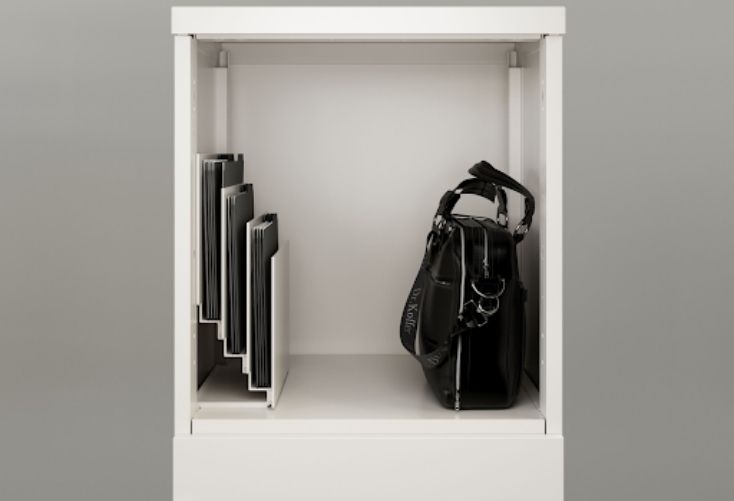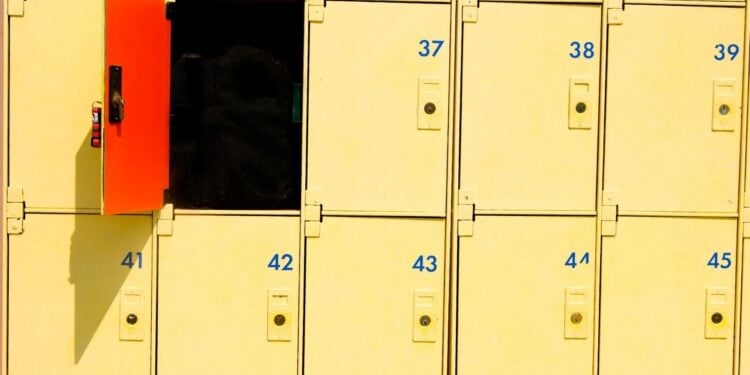- Lockers can be used to define spaces and create boundaries between work and non-work areas.
- Hybrid work is driving the desire for personalisation and keyless access.
- People are also establishing boundaries to create a clearer distinction between work and life. And secure, personal storage spaces – as functional as they are – can help.
Lockers are an obvious but often overlooked amenity in shared workspaces. As well as providing storage so that workers can enjoy an uncluttered environment, lockers can be used to define spaces and create boundaries between work and non-work areas.
We caught up with Allyson Ramsay, Category Director, Systems at Teknion, and Laura Barski, Vice President of Marketing and Product Design at Inscape/ Office Specialty to find out about the role storage solutions are playing in today’s hybrid work environment.

Designing for today’s flexible workspaces
The way designers specify lockers has evolved.
“The office landscape is ever-changing. Now more than ever, with the rise of hybrid work, there is an increased need for storage for both personal items and to keep a clutter-free workspace,” says Barski.
Hybrid work is driving the desire for personalisation and keyless access.
“Designers are utilising colours, materials, textures, and alternatives to the traditional ‘lock and key’ format of lockers to make them unique. Today, the integration of digital locking technologies is becoming more important,” Ramsay explains.
Barski adds: ”The rotating work schedule has demonstrated how essential personalised and customizable lockers, especially with digital locks, are to the workplace.”
In today’s (good) offices, lockers are a far cry from the utilitarian storage facilities we associate with the dim and characterless workspaces of the 1980s. As Ramsay puts it, they are “pieces of furniture that occupy a large part of a floor plan”.
Lockers are multifunctional, making them the perfect fit for flexible workspaces that may require reconfiguration at very short notice.
“For example, tall lockers are often used to create space division in a floor plan and act as a functional storage wall. Additionally, counter-height lockers are often gathered together to create a standing workspace for employees to use.”
Lockers can be utilised as:
- Storage
- Dividers/ partitions
- Work surfaces or countertops
- Seating
- Standing desks
Some companies design locker systems in line with the customer’s individual taste and needs. In today’s uncertain landscape, needs can change quickly, so agility is important.
“As companies grow, offices move, and workspaces change, modular interiors allow you to change your storage and layout. Using lockers as a partition makes the office more adaptable for its employees,” says Barski.
Designing with sustainability in mind
The construction industry accounts for 38% of all CO2 emissions. Allwork.Space has written about how designers have a responsibility to advise their clients on the environmental and social impact of products, materials and technologies.
With this in mind, we asked Ramsay and Barski to run through their respective brand’s sustainability credentials.
It’s important for product designers and retailers to understand their embodied carbon emissions, which relate to the manufacturing, processing, transportation, assembly, maintenance, replacement, and deconstruction and disposal of goods.
“For Teknion, most of our environmental impact relates to the design and manufacturing of our products – the materials we use, how products are designed, made, and transported, and how they perform in our customers’ spaces,” says Ramsay.
80% of Teknion’s component parts are manufactured in-house, they add. This approach has enabled Teknion to surpass the minimum requirements for third-party certification during the manufacturing process. Foundation Programs the organisation has chosen include:
- ISO 14001: Environmental Management System to reduce environmental impact
- DfE: 11 Design for Environment guidelines addressing a product’s entire life at the design stage
- FSC®: Preserving forests
- GREENGUARD: Improving indoor air quality
- BIFMA e3 Level: Reducing environmental and social impacts of furniture within the built environment
- SCS Global Services: Leadership in environmental and sustainability certification, auditing, testing, and standards
- LEED: Reducing environmental impact within the built environment
If made well, lockers have a long life span and can be functional for decades. But when a Teknion solution is no longer required, the customer can donate, recycle or sell the item through the company’s Divert program.
The ultimate goal is to avoid waste from ending up in landfill.
Inscape’s storage solutions are also built to last (the highest gauges of steel are used in manufacturing), and products’ reconfigurability further extends their lifecycle, says Barski.
“The commitment to LEVEL® certification reflects our belief that sustainability is defined by multiple perspectives, including a company’s social actions, energy usage, material selection, and human and ecosystem health impacts,” according to Barski.
“Our environmental responsibility begins with procurement. Our efforts are channelled towards recycling and reclaiming waste material originating from production. We consciously work with our suppliers to ensure eco-friendly materials enter our manufacturing facilities,” says Barski.
Office Speciality monitors all waste in the manufacturing process, adds Barski.
- Packaging materials consist of 97% recycled content
- Corrugated cardboard is part of a closed-loop recycling system
- Metal and foil waste is collected and sent off-site for recycling purposes
- Scrap fabrics are converted into rags for cleaning
- Waste water channels through a recycling tank at an Ontario facility for reuse
Designing for employee wellbeing
With flexible working becoming more widespread, people’s personal and professional lives are intersecting.
Yet in an attempt to avoid burnout and improve their overall wellbeing, people are also establishing boundaries to create a clearer distinction between work and life. And secure, personal storage spaces – as functional as they are – can help.

“Remote work has blurred the line between work and home,” says Barski. “As designers move beyond designated desks, lockers can give employees a ‘home away from home’ by feeling comfortable and safe to leave personal belongings at work and create a separation between work and personal life.”
Ramsay agrees.
“We all have such busy lives outside of work that we need to have a space for our belongings while working at the office. Lockers allow us to spend more time doing the things we enjoy; people don’t have to rush home after work to grab their things because they are locked away at the office,” says Ramsay.


 Dr. Gleb Tsipursky – The Office Whisperer
Dr. Gleb Tsipursky – The Office Whisperer Nirit Cohen – WorkFutures
Nirit Cohen – WorkFutures Angela Howard – Culture Expert
Angela Howard – Culture Expert Drew Jones – Design & Innovation
Drew Jones – Design & Innovation Jonathan Price – CRE & Flex Expert
Jonathan Price – CRE & Flex Expert














